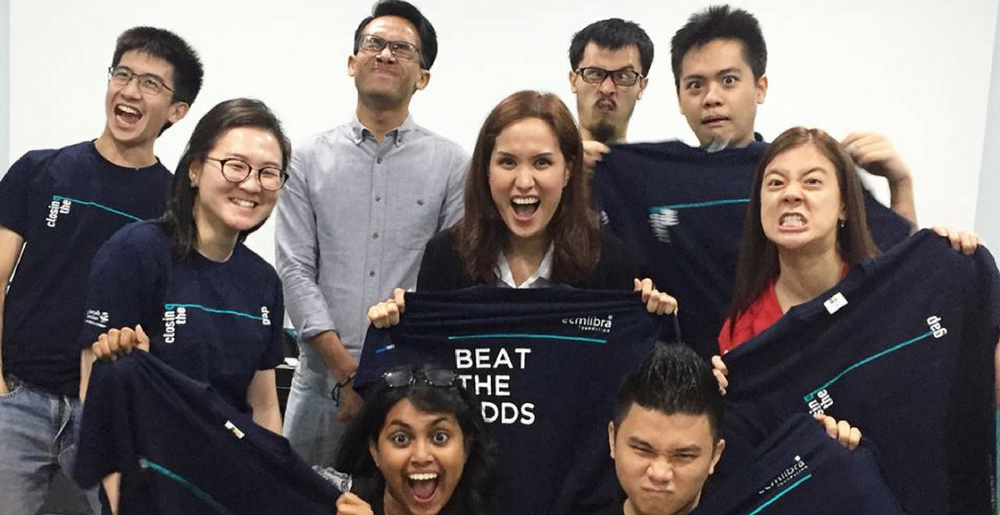Closing The Gap is a non-profit organisation that aims to help underprivileged children from disadvantaged families achieve the possibility of higher education through mentoring programs and support provided by the team.
The four people behind the idea are Brian Geh, Cheah Kok Hin, Ida Thien and Connie Foong. They met at a Teach For Malaysia fellowship programme.
“Brian, Kok Hin and I are Teach For Malaysia alumni from the first cohort. We taught in some of the most challenging schools in the Klang Valley during the Teach For Malaysia fellowship. Ida works in the Alumni Impact team in Teach For Malaysia,” Connie said.
The education backgrounds of the group varies greatly. Kok Hin did a Commerce degree and Brian read Math; both are now in management consulting. Ida’s background is in Law, while Connie majored in English and Music.
“But somehow we’ve wound up together through this shared passion to close the gap for disadvantaged students.”
They started Closing The Gap a year ago in late August and are currently 10 months into their pilot programme.
Based on the Futures Programme that is run by TFM’s sister organisation in the UK, Teach First UK, they look out for promising students from low-income families, and provide them with a personal mentor to teach, guide, and empower these students with the knowledge for them to reach their highest potential.

“Everything we’re doing is centered around this question: What does a kid from a low-income background need in order to succeed?”
Their motivation to make higher education accessible for disadvantaged kids stemmed from a frustration of how uneven the playing field is for the less fortunate community, even for those who are really bright. The odds are often more stacked up against them, simply because of their socioeconomic circumstances.
Their experience in teaching in schools from the TFM Fellowship also played a huge part in spurring them to start CTG.
“During our Fellowship experience, we taught some really remarkable kids who did really well. They have so much potential to succeed, if only they are given the right opportunities. The unfortunate reality is that your socioeconomic circumstances really limit your choices and force you to make less than ideal decisions that sacrifices long-term benefits for survival in the short term.”
The spark that drove them to this endeavour was an encounter with one of Brian’s students, Shawn, during their Teach For Malaysia Fellowship period.
“‘Shawn’ is a really smart boy who’s gifted in Maths. He did really well in his STPM, and wanted to pursue higher education. However he faced financial difficulties, especially coming from a family where his mom is the sole breadwinner.”
“The potential in Shawn was too great to ignore, so Brian took it upon himself to mentor him and guide him on the path towards securing a scholarship—and several months and hurdles later, Shawn successfully secured a scholarship at Sunway University to pursue his undergraduate studies.”
“That was a really joyful moment, and also one that affirmed the need for a programme like CTG.”
Since the start of their programme, a large part of it has gone into adapting it to fit Malaysian students and ensuring their needs are met.
They do this through a focus on mentoring, post-SPM exposure and scholarship preparation to help them prepare for the future. Essential life skills such as interviewing skills and writing personal statements are also added to the training programme.
Each batch is constantly refined and restructured to further enhance the students’ critical thinking problem-solving skills.
“The most significant milestone, though, is probably seeing two of our post-SPM students receive scholarships for their pre-university studies at MCKL, thanks to The Star Education Fund. Words can’t describe how happy we all were when we got the news. It felt like a validation that we’re on the right path.”
The CTG team is fortunate enough to receive funding from external donors, particularly from ECM Libra Foundation and CIMB Islamic. A private funder’s donation also allowed them to have one dedicated full-time person to run CTG.
They have also received tremendous support and backing from Teach From Malaysia and Sunway University during their events, which is evident from their venues that were used as locations for their workshops.

The first iteration of Closing The Gap was actually a literacy programme that was run in two different schools from 2012 to 2014.
They faced obstacles in getting students to participate and for a while, couldn’t keep a steady stream of volunteers. That was solved when they partnered with the Bank Negara Volunteers Group.
However, they had to put it on hiatus after a TFM alumna of theirs who was managing the programme was transferred to a different school.
“So when this idea came about, we decided to repurpose the name—also Brian and I had been part of the original Closing The Gap team,” Connie said.
The mentors in the current CTG work on a volunteer basis, but that doesn’t mean that they aren’t committed. The team makes it very clear that it’s not a one-off thing, and they’ve also reached out again to the Bank Negara volunteers this time round.
The TFM alumni network is another source of mentors, and they’ve recruited a number of their friends to help.
“These connections somehow translated into a positive domino effect, so people reached out to us and said they wanted to mentor our kids. Our mentors were required attend a training workshop before meeting their mentees on launch day.”

Connie added that they also communicate a similar level commitment to their students—an online application is needed for them to fill out and submit to be considered for the programme. The students also need to attend workshops, camps and commit regularly to meeting their mentors.
As for their current obstacles, Connie mentioned that logistics was their main challenge as their first batch of children came from different schools all over Klang Valley.
In fact, their furthest student is a boy from Sekinchan, which is located two hours away from KL.
“We believe it’s important for our students to be exposed to different environments, so figuring out how to get our students to those venues has been a challenge, especially when they live far away and access to public transport is limited. Their parents are usually busy with work, so they don’t really have anyone to drive them.”
When it comes to commitment, that’s something they’re still trying to work out with the students. Many of the students join the programme when they are starting Form 5, which is stressful as they’re often worried about SPM.
“It’s also about opening up their mindsets and worldviews, and helping them realise how important it is for them to begin thinking about their post-SPM plans now.”
They were actually part of MaGIC Global Accelerator Programme earlier this year, but pulled out after a month because they realised they were not ready to monetise.
“We want to focus on making sure our programme is first and foremost, solid and done right. So as to whether we will become a social enterprise is something we are still exploring.”
“But in our journey so far, we’ve learned and seen how difficult it is for many social enterprises to develop sustainable business models, especially in this region, where philanthropic mindsets and emphasis on social good are still at a nascent stage.”
Their continuing challenge is as always, funding. They are set for their first year and some of the next, and they observed that programmes like theirs are quite fortunate in Malaysia—there are many grants available for CSR-type programmes like CTG, whether it’s education or environment or community development.
“Unfortunately, not many are willing to cover operation or administrative costs. But if you really want the programme to be done well and see longer-term sustainability and benefits, you need dedicated people who can manage and run those programmes.”
Feature Image Credit: Closing The Gap













